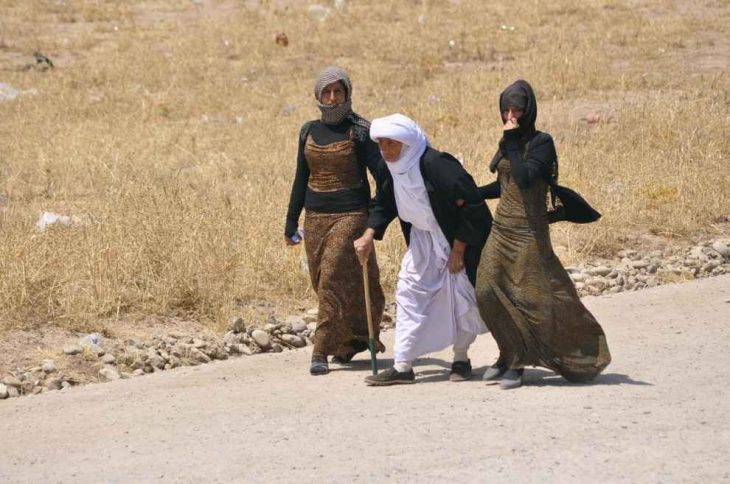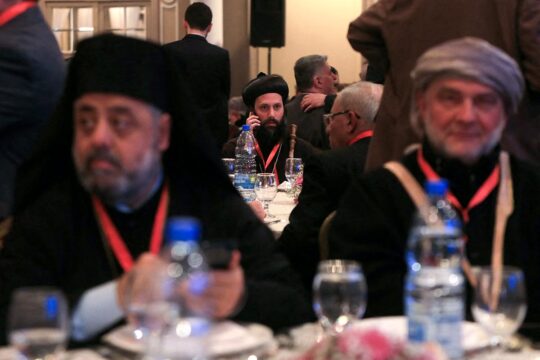This post originally appeared on the Advanced Training Program on Humanitarian Action (ATHA) blog, a program of the Harvard Humanitarian Initiative.
ISIS is committing genocide and other international crimes against the Yazidi minority in Iraq and Syria, as determined by the latest report of the Independent International Commission of Inquiry on the Syrian Arab Republic. According to the Commission, at least 3,200 Yazidi women and children remain in the hands of ISIS, and thousands of Yazidi men and boys are missing, meaning that “[t]he genocide of the Yazidis is ongoing.” The Commission’s report also underscores an important realization – that the logic, nature, and commission of genocide is highly gendered – and that legal, policy and humanitarian responses must take account of this reality.
First they kill the men, then they take the women
With its attack on the Sinjar region of northern Iraq on 3 August 2014 - two years ago this week - ISIS set in motion a targeted campaign of destruction of the Yazidis, a small ethnic and religious minority long persecuted as accused ‘unbelievers’ or ‘infidels’. As ISIS targeted the Yazidi community – both men and women – for destruction as a distinct religious group, argues the report, its violence followed strictly a gendered logic and pattern.
After capturing Yazidi families in Sinjar, ISIS fighters first separated men and boys from women and younger children. For thousands of Yazidi men and boys aged approximately 12 and above, this initially meant forced conversion to Islam or summary execution. Those forcibly converted to Islam were transferred to other sites and forced in labor as ISIS captives; many were not heard from again. While Yazidi boys were initially held captive along with their mothers, those aged seven and above were eventually separated and taken to ISIS training camps, where they are indoctrinated as ISIS fighters alongside Sunni Arab boys, while also being systematically stripped of their Yazidi identities – including through forcible conversion to Islam and the imposition of new names and identities.
For thousands of Yazidi women and girls aged 9 and above, capture means forced separation from their families and transfer to multiple holding sites in Iraq and Syria where they have been held captive, abused, and sold at market to other ISIS members as sex slaves. Younger children were initially held in captivity and slavery along with their mothers – suffering abuse and violence as well as witnessing the prolonged and intensive suffering of their mothers. Upon reaching the age of nine, girls have also been separated and sold into slavery.
The “distinct and systematic violations” suffered by each group, notes the report, are sanctioned under ISIS’s strict ideological framework. This radical theology, writes Rukmini Callimachi, emphasizes a “narrow and selective reading of the Quran and other religious rulings to not only justify violence, but also to elevate and celebrate each sexual assault as spiritually beneficial, even virtuous.”
Gender and genocide
ISIS’s highly gendered crimes against Yazidi women, men, girls, and boys – amounting to genocide in the view of the Commission – follow a pattern seen in a number of other conflicts, from Bosnia and Rwanda to Darfur, Iraq and Syria. While research shows that sexual and gender-based violence (SGBV) is not inevitable in armed conflict, preventing, suppressing and punishing such violence remains a major challenge. Moreover, developments in international law and jurisprudence in recent decades have ensured that SGBV, while still prevalent, is now punishable as an international crime. Therefore, the handling of SGBV serves as an illustrative lens for understanding the evolution of international law with regard to gender and atrocities; as previously noted here, IHL explicitly prohibits sexual violence as a weapon of war, and a growing list of sexual and gender-based crimes are punishable internationally, including as war crimes, crimes against humanity and of genocide.
The International Criminal Tribunal for the former Yugoslavia (ICTY) was the first to recognize rape and sexual slavery as war crimes and crime against humanity, starting with a 1996 indictment and 2001 conviction in the Foca case. The Rome Statute of the International Criminal Court (ICC), adopted two years later, also defines rape as a war crime, crime against humanity and acts of genocide; this year, the Bemba case (2016) marked the ICC’s first conviction of sexual violence crimes, with rape as both a war crime and crime against humanity.
Sexual and gender-based violence is also increasingly recognized as a central element of the crime of genocide. Article II of the 1948 Genocide Convention defines genocide as:
any of the following acts committed with intent to destroy, in whole or in part, a national, ethnical, racial or religious group, as such:
(a) Killing members of the group;
(b) Causing serious bodily or mental harm to members of the group;
(c) Deliberately inflicting on the group conditions of life calculated to bring about its physical destruction in whole or in part;
(d) Imposing measures intended to prevent births within the group;
(e) Forcibly transferring children of the group to another group.
While gender is not explicitly listed as one of the protected groups (i.e. national, ethnical, racial or religious) under the Convention – and was not considered by the drafters at the time – it is implicit in several of the prohibited acts, including the prevention of births and forcible transfer of children.
However, sexual and gender-based violence has increasingly been recognized as a key component of genocide through the jurisprudence of international criminal tribunals. In 1998, for instance, the International Criminal Tribunal for Rwanda (ICTR) issued the first ever conviction of rape as a component of genocide in the Akayesu case. The Trail Chamber held that:
These rapes resulted in the physical and psychological destruction of the Tutsi women, their families and their communities. Sexual violence was an integral part of the process of destruction, specifically targeting Tutsi women and specifically contributing to their destruction and to the destruction of the Tutsi group as a whole (para. 731).
[…] Sexual violence was a step in the process of destruction of the tutsi group -destruction of the spirit, of the will to live, and of life itself (para. 732).
That same year, the ICTY confirmed in the Furundžija case that rape may be a tool of genocide, and in 2001 it established a link between rape and ethnic cleansing as a precursor to genocide in the Krstić case.
Indeed, the pattern of genocide in Bosnia, as in other countries, showed strong similarities with that of ISIS against the Yazidis, including the capture and separation of men from women and children, execution of men, forcible transfer and systematic rape and sexual slavery of Bosniak women and girls. A notable difference between the two cases is the forced impregnation of Bosniak women with “Serb” babies, whereas ISIS has forced birth control on Yazidi captives to prevent births; both methods, however, seek to prevent births within the group and transfer children to the other group – prohibited acts of genocide.
“In the public imagination, genocide often signifies organized mass killing,” says Sareta Ashraph, chief analyst on the Independent International Commission of Inquiry on the Syrian Arab Republic, “The ongoing genocide of the Yazidis underscores that genocide can be committed through gendered non-killing crimes, such as rape and violence. Historically, alongside killings, it is these prohibited acts that often comprise the female experience of genocide.”
Sexual and gender-based violence can therefore be considered a crime in multiple senses: as an act of genocide; as a war crime or crime against humanity against the women (and men) who suffer it directly; and as an offense against the relatives and communities of the victims. As the Commission’s report notes, “Yazidi women and girls are not […] simply vessels through which ISIS seeks to achieve the destruction of the Yazidi religious group. Rape and sexual violence, when committed against women and girls as part of a genocide, is a crime against a wider protected group, but it is equally a crime committed against a female, as an individual, on the basis of her sex.” Furthermore, sexual and gender-based violence against women in conflict is also a means of targeting men and their masculinity; violence against women serves as tactic to symbolically ‘emasculate’ enemy men by demonstrating their failure to protect the physical and moral integrity of ‘their’ females, and by extension, their communities.
Seeking a path to justice
While increasing international attention has focused on recognizing sexual and gender-based violence as a crime under international law, a significant gap remains in accountability for the vast majority of perpetrators, and in justice and assistance for the vast majority of victims. Nadia Murad, a survivor of these atrocities and now a Yazidi rights activist, has been particularly outspoken in demanding justice for these crimes:
We don’t need more speeches, we need justice. […] It is time for this tragedy to stop, and it is time for the world to see our wounds. […] It is my right to ask the world to be on my side. ISIS attacked us and killed us in our houses. They killed my brother and my mother. They kidnapped me and other girls with me. It is my right to request you to bring justice.
Murad and the Yazidi organization Yazda are seeking an investigation and prosecution by the ICC for crimes against her and the Yazidi community. The Commission’s report is an important step in this direction. “Of course,” says Commissioner Carla del Ponte, “we regard that as a road map for prosecution, for future prosecution.” Yet thus far, as the report notes, the path to prosecution of ISIS members for these crimes has been largely blocked by international politics and the lack of ICC jurisdiction over crimes committed in Iraq and Syria.
There remains a critical need to open new avenues for accountability – whether through a Security Council referral to the ICC, the establishment of an ad hoc tribunal, or domestic prosecutions in national jurisdictions of ISIS members- as well as need to improve the assistance available to victims. To fight the prevailing culture of impunity for sexual and gender-based violence in conflict requires states and the international community to overcome the political barriers to prosecution of these crimes – whether at the domestic or international level – and to provide more effective assistance to victims with gender-sensitive needs in mind. Given the ongoing nature of these violations, it also means developing more effective tools of prevention and repression of these atrocity crimes. And for humanitarian actors, it means enhanced provision of psychological, material and legal support to victims, especially the many Yazidi female survivors now living in displacement, as well as contributions where possible to documentation, advocacy and accountability efforts on their behalf.
“With so many highly traumatized but living victims of this genocide,” says Ashraph, “one sees clearly what the drafters of the Genocide Convention understood: it possible to destroy a protected group, without necessarily killing all, or even most, of its members.” Now, these survivors are demanding assistance from an international community that many feel has already betrayed them.
As ISIS has demonstrated in Iraq and Syria, gender-based crimes remain an all-too-common feature of contemporary conflicts, and a central element of the crime of genocide. Understanding this gendered logic and pattern of violence is key to not only better preventing and punishing such crimes in the future, but also to better serving the needs of victims and their communities for a long time to come.






